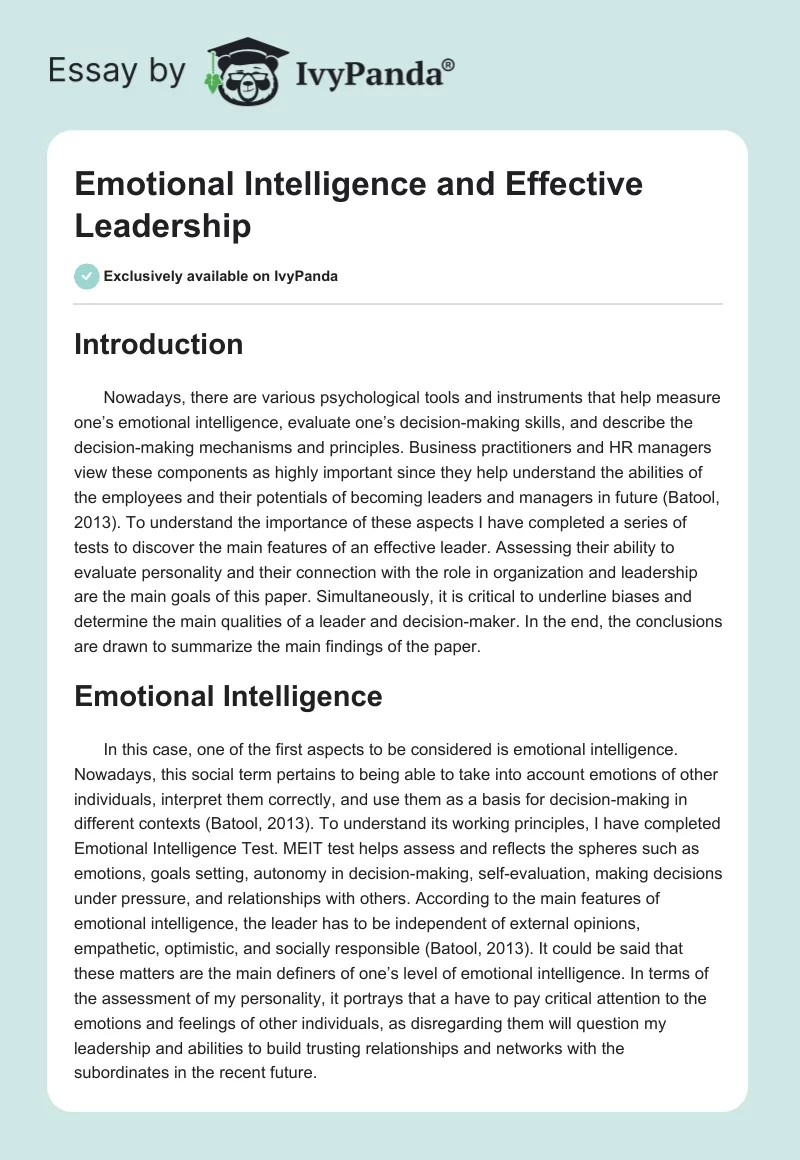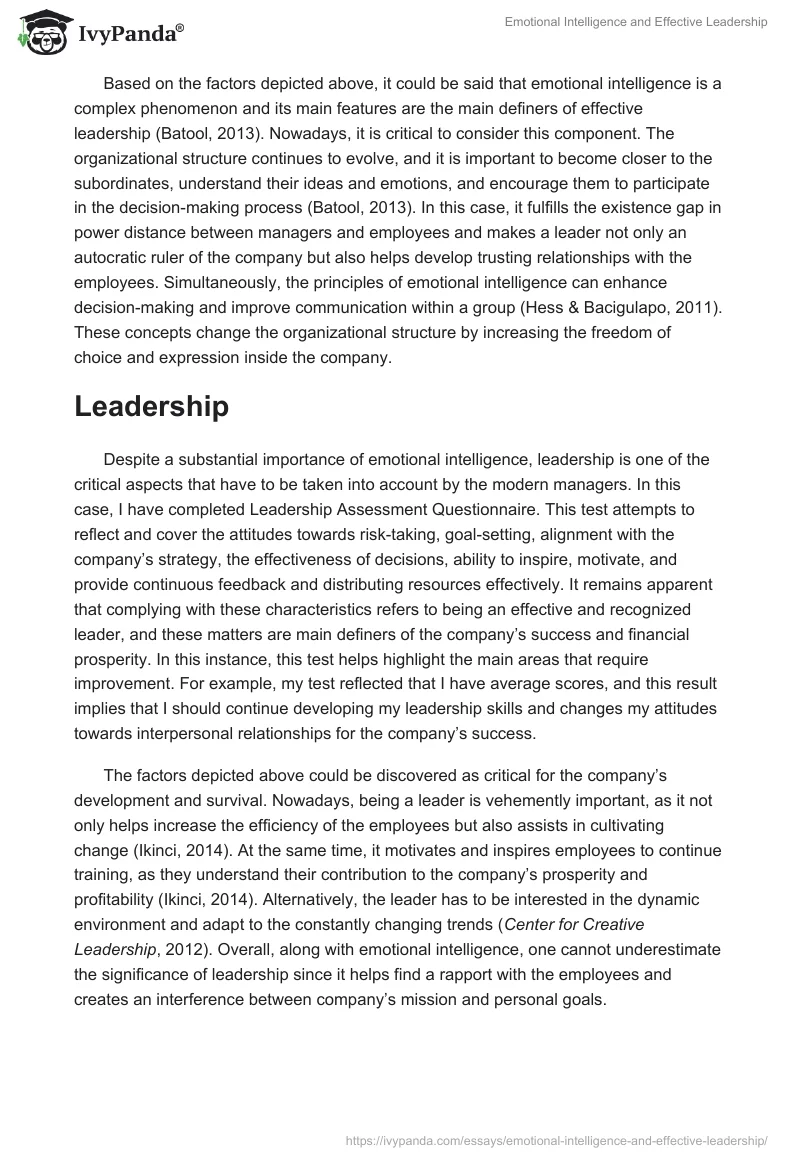Introduction
Nowadays, there are various psychological tools and instruments that help measure one’s emotional intelligence, evaluate one’s decision-making skills, and describe the decision-making mechanisms and principles. Business practitioners and HR managers view these components as highly important since they help understand the abilities of the employees and their potentials of becoming leaders and managers in future (Batool, 2013).
To understand the importance of these aspects I have completed a series of tests to discover the main features of an effective leader. Assessing their ability to evaluate personality and their connection with the role in organization and leadership are the main goals of this paper. Simultaneously, it is critical to underline biases and determine the main qualities of a leader and decision-maker. In the end, the conclusions are drawn to summarize the main findings of the paper.
Emotional Intelligence
In this case, one of the first aspects to be considered is emotional intelligence. Nowadays, this social term pertains to being able to take into account emotions of other individuals, interpret them correctly, and use them as a basis for decision-making in different contexts (Batool, 2013). To understand its working principles, I have completed Emotional Intelligence Test. MEIT test helps assess and reflects the spheres such as emotions, goals setting, autonomy in decision-making, self-evaluation, making decisions under pressure, and relationships with others.
According to the main features of emotional intelligence, the leader has to be independent of external opinions, empathetic, optimistic, and socially responsible (Batool, 2013). It could be said that these matters are the main definers of one’s level of emotional intelligence. In terms of the assessment of my personality, it portrays that a have to pay critical attention to the emotions and feelings of other individuals, as disregarding them will question my leadership and abilities to build trusting relationships and networks with the subordinates in the recent future.
Based on the factors depicted above, it could be said that emotional intelligence is a complex phenomenon and its main features are the main definers of effective leadership (Batool, 2013). Nowadays, it is critical to consider this component. The organizational structure continues to evolve, and it is important to become closer to the subordinates, understand their ideas and emotions, and encourage them to participate in the decision-making process (Batool, 2013).
In this case, it fulfills the existence gap in power distance between managers and employees and makes a leader not only an autocratic ruler of the company but also helps develop trusting relationships with the employees. Simultaneously, the principles of emotional intelligence can enhance decision-making and improve communication within a group (Hess & Bacigulapo, 2011). These concepts change the organizational structure by increasing the freedom of choice and expression inside the company.
Leadership
Despite a substantial importance of emotional intelligence, leadership is one of the critical aspects that have to be taken into account by the modern managers. In this case, I have completed Leadership Assessment Questionnaire. This test attempts to reflect and cover the attitudes towards risk-taking, goal-setting, alignment with the company’s strategy, the effectiveness of decisions, ability to inspire, motivate, and provide continuous feedback and distributing resources effectively. It remains apparent that complying with these characteristics refers to being an effective and recognized leader, and these matters are main definers of the company’s success and financial prosperity. In this instance, this test helps highlight the main areas that require improvement. For example, my test reflected that I have average scores, and this result implies that I should continue developing my leadership skills and changes my attitudes towards interpersonal relationships for the company’s success.
The factors depicted above could be discovered as critical for the company’s development and survival. Nowadays, being a leader is vehemently important, as it not only helps increase the efficiency of the employees but also assists in cultivating change (Ikinci, 2014). At the same time, it motivates and inspires employees to continue training, as they understand their contribution to the company’s prosperity and profitability (Ikinci, 2014). Alternatively, the leader has to be interested in the dynamic environment and adapt to the constantly changing trends (Center for Creative Leadership, 2012). Overall, along with emotional intelligence, one cannot underestimate the significance of leadership since it helps find a rapport with the employees and creates an interference between company’s mission and personal goals.
Decision-Making
Another matter that has a clear connection with the organizational effectiveness is the principles of decision-making. In this case, the test How Good Is Your Decision-Making helped me understand my personal traits and competences. In the first place, this test tends to cover topics such as principles of decision-making and potential sources of bias such as emotionality. This assessment has a clear connection with the main features of the effective decision-maker that may include rationality, critical thinking, strong support by facts, a reasonable involvement of intuition, and risk assessment. As for my personal assessment, the score indicated that I tend to rely on rational decision-making.
The primary benefit of this approach is its strong focus on logic and factual support (Walter, Kellermanns, & Lechner, 2010). Nonetheless, I have to focus on the development of my intuitive skills, as the business environment may experience unpredictable changes and require making decisions quickly.
The main features of the concept mentioned above emphasize that it could be considered as equally important as leadership and emotional intelligence. It could be said that this aspect helps the organization select only rational and logical options that may have a beneficial influence on the firm’s stability and financial performance (Walter et al., 2010). At the same time, it assists in avoiding external risks and modifying the organizational culture to comply with the external trends and fluctuations of the economic cycles. Underestimating this matter may lead to failure and a substantial financial loss.
Biases and Becoming Effective Leader and Decision-Maker
Despite the clarity of the decision-making and its well-balanced intuitive and logical components, there are various external factors that affect the effectiveness of selecting a particular option. The assessment presented above attempted to cover some types of biases. One of them is emotionality, as they leaders tend to rely on intuition while overconfident that a particular event will take place (Murata, Nakamura, & Karwowski, 2015).
Apart from the cognitive biases that tend to underestimate the possibility of the social influence, there are various phenomena such as groupthink (Murata et al. 2015). In this case, the inability to discover issue from dissimilar angles minimizes the effectiveness of decision-making and may be discovered as a potential cause of failure or financial loss. It remains evident that different biases and external factors have to be considered at the same time since underestimating them will question the effectiveness of the leadership style and selected decision-making strategy.
Based on the assessments mentioned above, it could be said that effective leader and decision-maker has to combine various emotional traits that include the main features of emotional intelligence, leadership, and the key principles of decision-making mechanisms. In this case, the leader has to pay attention to the emotions of other individuals and take them into account when making particular decisions (Batool, 2013). At the same time, one cannot underestimate the importance of social responsibility and ensuring alignment with the personal and group goals with the company’s mission. Using a well-balanced combination of intuition and rationality will also boost the efficiency of decision-making and have a positive impact on the development of the company. Being able to combine these features will contribute to being a motivating and inspiring role model to the employees and effective problem-solver.
Conclusion
Overall, this essay helped see that personal assessments are not only completed for pleasure and entertainment, but they also identify the areas for improvement. They tend to take into account the characteristics that one has to have a high level of emotional intelligence and be effective leader and decision-maker. These tests helped understand the significance of individual traits and emotional features in the organizational structure and success of the company.
At the same time, this essay tends to underline that these concepts are vehemently important for the organizational performance and have to be considered as the main components of the effective leadership and decision-making. Using their combination will have a positive impact on establishing internal and external relationships and change the principles of the decision-making style. Following these new tendencies will assist the leader in establishing trusting relationships with the employees and creating a suitable environment for encouraging employees to share their opinions. It could be said that these factors will not only optimize the working processes of the company but also enhance company’s competitive edge.
References
Batool, B. (2013). Emotional intelligence and effective leadership. Journal of Business Studies Quarterly, 4(3), 84-94.
Center for Creative Leadership: Leadership image. (2012). Web.
Hess, J., & Bacigulapo, A. (2011). Enhancing decisions and decision-making processes through the application of emotional intelligence. Management Decisions, 49(5), 720-721.
Ikinci, S. (2014). Organizational change: Importance of leadership style and training. Management and Organizational Studies, 1(2), 122-128.
Murata, A., Nakamura, T., & Karwowski, W. (2015). Influence of cognitive biases on distortive decision-making and leading to critical unfavorable incidents. Safety, 1(1), 44-58.
Walter, J., Kellermanns, F., & Lechner, C. (2012). Decision making within and between organizations: Rationality, politics, and alliance performance. Journal of Management, 38(5), 1582-1610.


